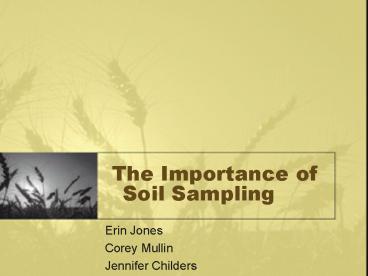The Importance of Soil Sampling - PowerPoint PPT Presentation
1 / 17
Title:
The Importance of Soil Sampling
Description:
6. Place the composite sample in a sample bag. Label the bag properly. 7. Allow sample to air dry to stabilize nitrogen. 8. The sample is sent for analysis. ... – PowerPoint PPT presentation
Number of Views:71
Avg rating:3.0/5.0
Title: The Importance of Soil Sampling
1
The Importance of Soil Sampling
- Erin Jones
- Corey Mullin
- Jennifer Childers
2
Soil sampling is a tool used to
- Evaluate soil properties (i.e. hard pan,
moisture, and the profile of the soil. - Maximize yields
- Determine fertility requirements for crops to
minimize inputs for lower input costs
3
The Importance of Sampling Correctly
- Poor sampling results in
- inaccurate test results
- misleading recommendations
- yield loss
- money loss
- nutrient loss
- The Soil Sample is only as good as the method
used.
4
Precision Sampling
- GPS
- Increases sampling location accuracy within -
15ft - Generates sampling history (when, how, and
acreage) - Incorporates data into precision fertilizer
application yield monitors
5
Sampling Field Plans
6
When to Sample
- The best time to sample is in the spring or fall
after crop removal and before planting.
7
Tools
- This is a Giddings Soil Probe used for
- High-volume, deep sampling
- Sandy, hard dense soil
8
Tools continued
- This sampling probe on the back of a 4-wheeler
- Is portable
- Provides high-volume, shallow sampling
9
Tools continued
- This is a Soil Auger used in
- Large samples
- Hard grounds
- Deep samples
10
Tools continued
- Soil probe
- Used for shallow sampling
- Portable
- Easy to extract soil
11
Tools continued
12
How to sample
- Remove excess plant residues.
- 2. When using a probe, push the tube into the
soil to the desired sample depth and collect the
individual sample. - 3. A composite should be taken every 40 acres.
13
How to sample
- 4. Mix all the individual samples into one
bucket. - 5. Then take a composite sample from the
mixture. - 6. Place the composite sample in a sample bag.
Label the bag properly. - 7. Allow sample to air dry to stabilize
nitrogen. - 8. The sample is sent for analysis.
14
Analysis Results
- Analysis Results inform the land owner of
- nutrients availability in the soil
- the cation exchange capacity
- fertilizer recommendation
- ways to improve yields
- when to apply nutrients (i.e. nitrogen,
phosphate)
15
Summary
- In conclusion proper soil sampling is a
foundation for a proper nutrient plan. There is a
variety of tools available for soil sampling. It
is important to follow proper procedures to
insure optimum results. The results provide the
necessary information for a sound nutrient plan.
16
- THE END
17
Sources
- www.mn.nrcs.usda.gov/technical/ecs/nutrient/plant
20nutrient/pla... - Servi-Tech Laboratories
- www.soilsample.com































